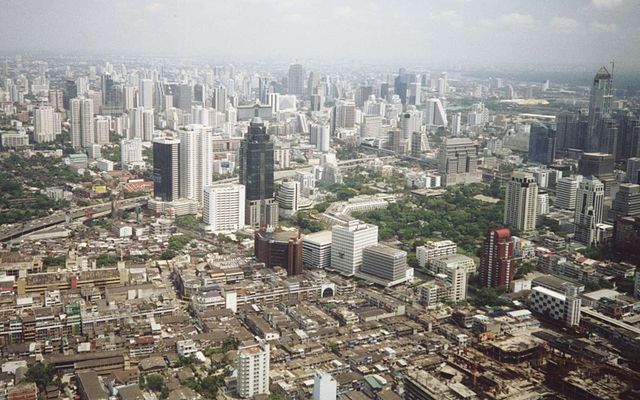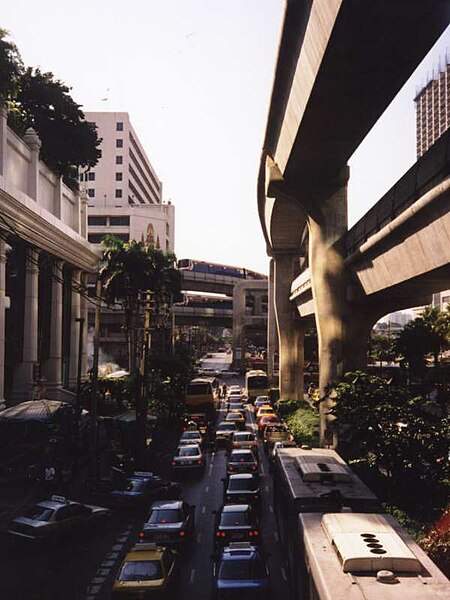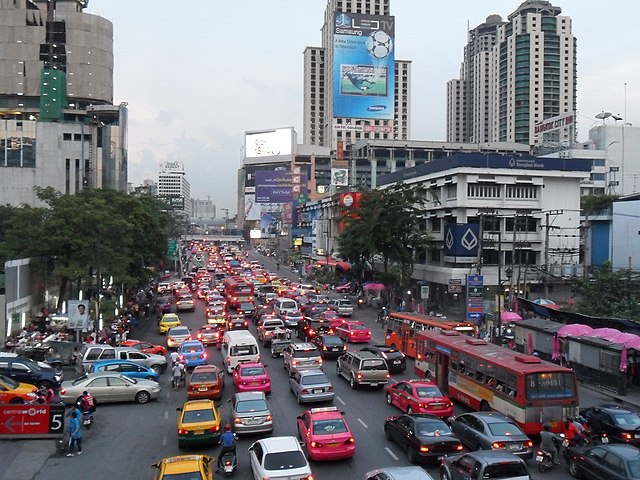
A book newly acquired by the Thammasat University Library explores agricultural innovations in cities. The Vertical Farm: Feeding the World in the 21st Century is by Dickson Despommier, an emeritus professor of microbiology and Public Health at Columbia University, New York. According to Professor Despommier, since increasing numbers of people live in cities, as populations grow it becomes more difficult to set aside farmland to grow crops to feed them. The Food and Agriculture Organization of the United Nations and the National Aeronautics and Space Administration (NASA) state that more than 80% of land suitable for raising crops is already being used for that purpose, and usually 15% of that is damaged or destroyed by inadequate farming methods. An experimental solution involves recycled and filtered water and organically raised crops, with no genetically modified organisms. Food produced in vertically stacked layers would use controlled-environment agriculture (CEA) technology, avoiding plant diseases and other problems. These vertical farms could be close to cities, reducing the energy used to transport food across long distances, and offering agricultural jobs close to urban centers. Some observers are concerned that vertical farming would be too much like factories, but Professor Despommier explains that growing crops inside tall city buildings would protect them from floods, droughts, and other weather. As Professor Despommier’s website states:
One solution involves the construction of urban food production centers – vertical farms – in which our food would be continuously grown inside of tall buildings within the built environment. If we could engineer this approach to food production, then no crops would ever fail due to severe weather events (floods, droughts, hurricanes, etc.). Produce would be available to city dwellers without the need to transport it thousands of miles from rural farms to city markets. Spoilage would be greatly reduced, since crops would be sold and consumed within moments after harvesting. If vertical farming in urban centers becomes the norm, then one anticipated long-term benefit would be the gradual repair of many of the world’s damaged ecosystems through the systematic abandonment of farmland. In temperate and tropical zones, the re-growth of hardwood forests could play a significant role in carbon sequestration and may help reverse current trends in global climate change. Other benefits of vertical farming include the creation of a sustainable urban environment that encourages good health for all who choose to live there; new employment opportunities, fewer abandoned lots and buildings, cleaner air, safe use of municipal liquid waste, and an abundant supply of safe drinking water.
There would be many requirements for this approach to be useful:
High-rise food-producing building will succeed only if they function by mimicking ecological process, namely by safely and efficiently re-cycling everything organic, and re-cycling water from human waste disposal plants, turning it back into drinking water. Most important, there must be strong, government-supported economic incentives to the private sector, as well as to universities and local government to develop the concept. Ideally, vertical farms must be: a. cheap to build; b. durable and safe to operate; and c. independent of economic subsides and outside support (i.e., show a profit at the end of the day). If these conditions can be realized through an on-going, comprehensive research program, urban agriculture could provide an abundant and varied food supply for the 60% of the people that will be living within cities by the year 2030.
Critics of the plan suggest that providing enough light for plants to grow in buildings will use too much energy. Real estate prices in cities are too expensive to devote lots of area to farming. Instead, crops may be grown on rooftops, in greenhouses, and other city places where natural lighting is possible. In 2014, New Scientist Magazine described some vertical farms already in operation in Asia. In Singapore, Jack Ng’s Sky Greens is, as its website notes, the
world’s first low carbon, hydraulic driven vertical farm. Using green urban solutions to achieve production of safe, fresh and delicious vegetables, using minimal land, water and energy resources.
In terms of technology, Sky Greens
consists of rotating tiers of growing troughs mounted on a A-shape aluminium frame. The frame can be as high as 9 meter tall with 38 tiers of growing troughs, which can accommodate the different growing media of soil or hydroponics. The troughs rotate around the aluminium frame to ensure that the plants receive uniform sunlight, irrigation and nutrients as they pass through different points in the structure.
High yield
When compared with traditional monolayer farms, the Sky Greens patented vertical farming system intensifies land use and can result in at least 10 times more yield per unit land area.
High quality
The structures are housed in a controlled environment which enables stringent control of input materials to bring about food supply, food safety, food security and food quality assurances.
High flexibility
Made of aluminum and steel, the modular structures are robust and yet highly customisable and scalable. Structures can be tailor-made to suit different crops, growing media and natural conditions, even allowing cultivation on originally non-arable lands.
Low energy use
With the harnessing of natural sunlight, there is no need for artificial lighting. Rotation is powered by a unique patented hydraulic water-driven system which utilises the momentum of flowing water and gravity to rotate the troughs. Only 40W electricity (equivalent to one light bulb) is needed to power one 9m tall tower.
Low water use
With the plants irrigated and fertilised using a flooding method, there is no need for a sprinkler system thereby eliminating electricity wastage, as well as water wastage due to run-offs. Only 0.5 litres of water is required to rotate the 1.7 ton vertical structure. The water is contained in a enclosed underground reservoir system and is recycled and reused.
Low maintenance
Being housed in a protected environment ensures that the system can be relatively maintenance-free and have low manpower dependency. The rotating troughs and intensified plant to plot ratio also mean high manpower efficiency.

In Kyoto, Japan, Nuvege is a vertical farm growing lettuce. Its building has no windows, using LED lighting instead. It produced 6 million lettuces annually for such clients as Subway and Disneyland Tokyo. South Korea, China, and other nations are developing plans for vertical farming. Until more research is available, definitive answers about the realism and productivity of vertical farming remain unavailable.
Urban farming in Thailand
In 2012, Kasetsart University constructed a rooftop garden on its Faculty of Architecture building to provide crops even in times of flooding. Funded by the Thai Health Promotion Foundation, the Faculty of Architecture and Kasetsart University, 196 square meters of herbs and vegetables are grown in a structure designed by Associate Professor Pasinee Sunakorn.
Back in 2003, the Laksi District Office building featured a rooftop farm growing over one hundred types of vegetables. Reports of other low-tech urban farming projects in Bangkok suggest that the process has a future. In 2014, a City Farm Festival in Bangkok was promoted by Nakorn Limpacuptathavon. His urban farming center in is Lad Prao district, Bangkok. Khun Nakorn earned a master’s degree in sustainable agriculture from Thammasat University. He told one website:
What I see in store for the future of urban farming is that there will be some forms of food production innovations – such as genetically modified organisms (GMOs) and large-scale vertical farming – that would try to present themselves as a choice for sustainability. Personally, I don’t think that we need GMOs now. But if you created a scenario where we need to move to another planet tomorrow, then GMO might be needed as a solution. As for large-scale vertical farming, I have known a Ph.D. researcher who is researching the viability of initiatives like this for Thailand’s large food corporations. I know that it’s coming and will challenge our concept of ‘sustainability,’ but I’m not sure how it will turn out.

(All images courtesy of Wikimedia Commons).

